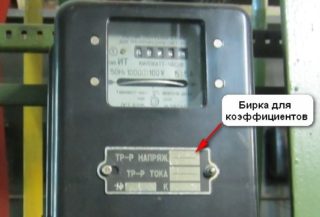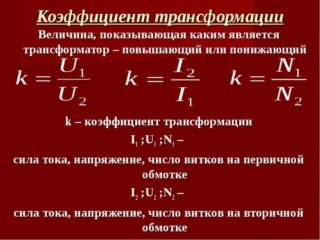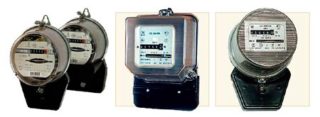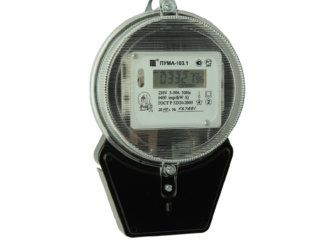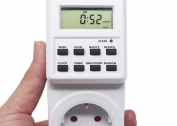On large buildings and facilities, special electricity control mechanisms are installed that are designed for volumetric current indicators (over 100A). Therefore, there is a need to install step-down transformers. For correct readings from all devices, a calculated electricity metering coefficient is needed.
What is the transformation ratio
The transformation coefficient of the electricity meter is a technical parameter that determines the accuracy of the readings of energy metering devices.
Electric meters of large facilities (industrial, commercial, other) are not connected to the common house network directly, because classical appliances do not provide the required voltage level. To reduce the likelihood of breakage, it is necessary to reduce the input power data through installed transformers.
The estimated electricity metering coefficient is an indicator reflecting the ratio of current strength and meter data. With a large amount of electricity consumed, the devices do not reflect the actual amount, therefore an additional calculation is applied. The figure of the coefficient is several points above the unit. When multiplying, the value of the actually consumed electricity is obtained.
Another point is the level of the transformer inaccuracy. Energy meters correspond to 0.5 or 0.2. The higher the value, the less accurate data the devices show.
Formula for determining CT
Calculation of the readings of the electric meter with current transformers and the corresponding coefficients is made according to a certain formula. The result reflects the necessary scaling - increase or decrease data. In other words, the transformer changes the voltage level and shows fluctuations in numbers.
To understand how to correctly read the readings of an electricity meter with current transformers, it is worthwhile to understand the formula used. In most cases, the transformation ratio is encrypted with the English letters k and n (other characters are less common). If the designation on the transformer is k ˂ 1, then the device works to increase, if k ˃ 1 - to decrease.
The general formula is as follows:

where: U1 is the input voltage level, U2 is the output level, N1 is the primary winding (number of turns), N2 is the secondary winding (number of turns).
This formula is used if the indicators of losses in the windings can be neglected. Otherwise, resort to the following calculations:

where: R1 and R2 are data on the resistance of the primary and secondary windings, respectively, I1 and I2 are the level of electric power at the corresponding turns.
For large objects, the formulas can be more complicated than those indicated so that the calculations take into account all the nuances and details of electricity consumption.
The coefficient of transformation (accounting) of the electric meter is the value by which the indicators of the meters are multiplied in order to obtain more correct data. For example, for home networks - 20 units. If you use the coefficient and numbers from the counter screen, you can get the amount of energy actually consumed.
Types of electricity meters
Electricity metering devices are multifunctional mechanisms that can reflect the current state of data, store and transmit important information. To date, three different versions of counting mechanisms are used.
Mechanical or induction meters
The classic type of device that is most common. The design consists of two conventional coils. One of them limits the data of alternating voltage, preventing distortion and receiving electric current. The second converts the AC voltage stream.
The main advantages are ease of use, durability of devices. The service life of meters of this type is high, and the cost is low. Minus - the dimensions of the mechanism.
Mechanical devices have a large error, which is very noticeable when used in networks with low voltage.
Electronic metering devices
Devices have a higher level of accuracy in the calculations, but their price is higher. An additional plus is the ability to function in several modes (for example, morning and night, two- and three-tariff devices).
Electronic meters convert incoming analog indicators into a special digital encoding, which in turn is converted by a small microcontroller. The received data can be seen on the display. Such devices are trying to install more often, replacing obsolete mechanical models.
Other advantages are compact size, the ability to remotely control.
Hybrid Meters
They are an average option between electronic and mechanical type of operation counter. On the one hand, the devices are equipped with a digital display for convenience. On the other hand, they use the classic induction method of obtaining and processing data.
Hybrid devices are rarely installed, preferring analog or electronic mechanisms.
Useful Tips
Electric meters allow you to see the amount of energy consumed in order to adequately estimate the consumption and calculate the final payment. Devices differ in accuracy class, power, degree of permissible error. To obtain accurate data, take readings, using the coefficient and calculator calculate the actual consumption.
For residential buildings in the urban zone and villages, small devices are used - single-phase meters (for example, Mercury 230 ART-03 CN, manufactured in Moscow) or multi-tariff devices suitable for 220 volt or 120 ampere networks.
It is important that each new device has a state-standard verification seal. Without this, the readings of the electric meter will not be considered reliable, and taken by regulatory authorities. You can choose the right meter and calculate the actual indicators yourself or through controllers.
